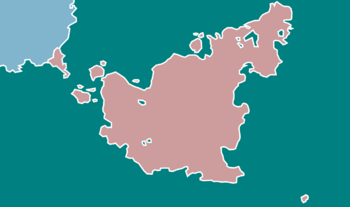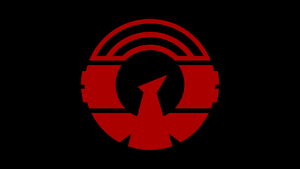User:JadziaChorus/Sandbox 1: Difference between revisions
JadziaChorus (talk | contribs) mNo edit summary |
JadziaChorus (talk | contribs) mNo edit summary |
||
| Line 5: | Line 5: | ||
|common_name = Aosta | |common_name = Aosta | ||
|image_flag = [[File:Aosta flag.png|thumb]] | |image_flag = [[File:Aosta flag.png|thumb]] | ||
|image_coat = | |image_coat = | ||
|symbol_type = Emblem | |symbol_type = Emblem | ||
|national_motto = Nati Uguali o Resi Uguali<br><small>''Born Equal or Made Equal''</small> | |national_motto = Nati Uguali o Resi Uguali<br><small>''Born Equal or Made Equal''</small> | ||
| Line 42: | Line 42: | ||
|established_date1 = 500 BCE | |established_date1 = 500 BCE | ||
|established_event2 = Province of Aosta | |established_event2 = Province of Aosta | ||
|established_date2 = | |established_date2 = 111 BCE | ||
|established_event3 = Aostan Colonial Authority | |established_event3 = Aostan Colonial Authority | ||
|established_date3 = 1530 | |established_date3 = 1530 | ||
| Line 59: | Line 59: | ||
|area_label = | |area_label = | ||
|area_dabodyalign = | |area_dabodyalign = | ||
|population_estimate = | |population_estimate = 50,013,112 | ||
|population_estimate_rank = | |population_estimate_rank = | ||
|population_estimate_year = 2020 | |population_estimate_year = 2020 | ||
Revision as of 17:22, 2 May 2023
Socialist Republic of Aosta Repubblica Socialista di Aosta | |
|---|---|
|
Flag | |
| Motto: Nati Uguali o Resi Uguali Born Equal or Made Equal | |
| Anthem: In Comradum Memoria (official) In Comradum Memoria | |
 Map of Aosta | |
| Capital and largest city | Rivoluzione |
| Recognised national languages | Lancian |
| Demonym(s) | Aostan (ethnic) Aostan (citizen) |
| Government | Anarcho-councilist republic |
| Ko'êtî Argento | |
| Gianotan Banche | |
| Legislature | Libera Assemblea del Popolo |
| Establishment | |
• First Contact | 500 BCE |
• Province of Aosta | 111 BCE |
• Aostan Colonial Authority | 1530 |
• Socialist Republic of Aosta | 1921 |
| Population | |
• 2020 estimate | 50,013,112 |
| Date format | dd.mm.yyyy |
| Driving side | right |
| ISO 3166 code | AO |
| Internet TLD | .ao |
Etymology
History
Antiquity
The origins of Aosta date back to 500 BCE when Lancian Emperor Caerndal declared the land beyond the Aostan (now Aeptan) Mountain chain to be named Aosta, erroneously believing the island to be leagues smaller than in actuality. Settlements on the eastern peninsula, such as Lux, would over time become culturally significant settlements and centers of Lancian imperialism throughout history.
Lancian Empire
Aosta quickly became the gateway from the heart of the Lancian Empire to the continent of Cesylle. While more quicker routes were discovered later, being the first Lancian settlement on Cesylle meant that Aosta made for a far more developed colony and therefore a more economically sound source of continental resources. The Governatores of Aosta were not immune to the political machinations of mainland Lancia, however, and the countless plots through the centuries kept Aosta from gathering any functional support for independence until the Era of Shadows.
Era of Shadows
With the decline of the Lancian Empire came the decline of the Aostan province. Ports once busy with commerce and soldiers struggled for decades as trade diminished and with it, the value of the Lancian lira. The Lancian settlements on the western portion of Aosta fell into siginificant disrepair and entire towns were abandoned as people moved to the eastern side of the island in search of better living standards and respite from native attackers.
Era of Honor
In the absence of imperial dominion, the mantle of power was assumed by the five most populous settlements and the surrounding regions: [BLANK], [BLANK], [BLANK], [BLANK], and [BLANK]. Given the distance between Aosta and Maris, few attempts were made to communicate between these kingdoms and Marisian societies, and so these kingdoms were largely left to their own devices. During their reign, the kingdoms managed to consolidate control over the remaining territory of the Aostan island and some of its daughter islands. However, much like the provinces in the fallen Lancian Empire, they were prone to competing power struggles, treacherous schemes, and at times, open warfare.
Return to Lancian Control
The following centuries saw the nation state of Lancia rise again as a fervor for reclaiming the empire's former glory swept the region. However, its growth on Maris was stifled by the birth of other kingdoms and nation states that desired to protect their own cultures and autonomy. So, Lancia turned outward and began to colonize Cel. One of its first priorities was to reclaim Aosta, which by now resembled a patchwork of kingdoms and polities. As the Aostan kingdoms were quite fierce in their attempts to remain independent (and the Lancian leadership were impatient to see their plans through), Lancia entered a state of open war against the many kingdoms of the island. Partway through this campaign, knowledge of firearms became known to Lancia, and so developed scenes of Lancian musketeers doing battle with Aostan knights and archers. In the end, it only took 77 years for Lancia to reclaim control over Aosta.
